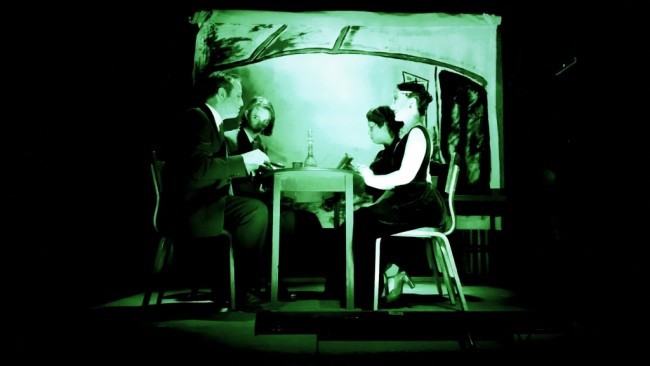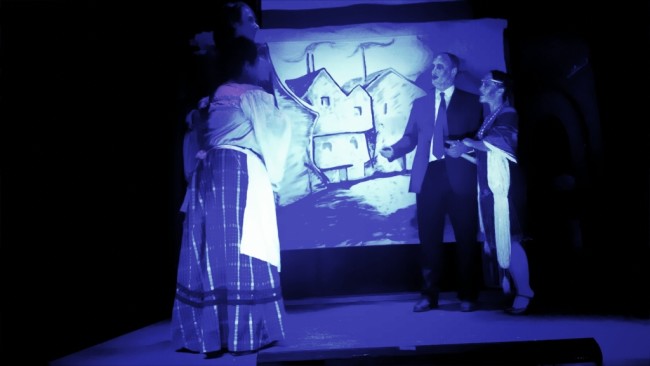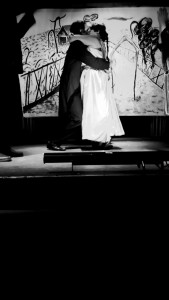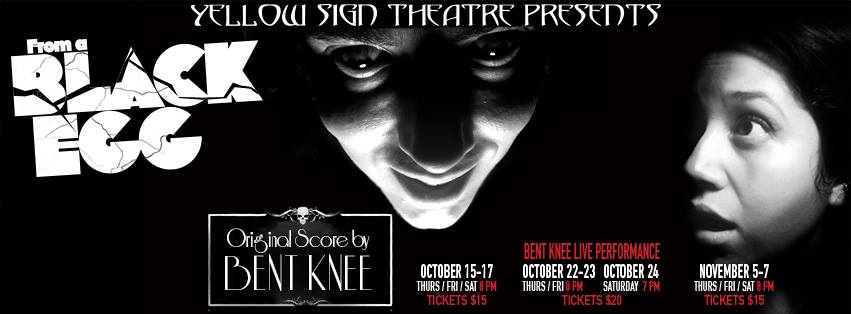Rebelling against the self-satisfaction of our civilization, at the crossroads where film and theatre intersect, a world premier work has settled itself into The Yellow Sign Theatre for the Halloween season. Written and Directed by Aaron Travis, From a Black Egg is an edgy new approach to the way theatre is experienced. Settling into the notion of German Expressionism and silent films, the work— in true Yellow Sign Theatre fashion— does not show you a mere silent film work adapted to the stage, but the crude inner mechanics of creating such a film. Following to the letter the mission statement principles of the company, Travis’ work presents an appreciation for the “low arts” as well as awakens an awareness to popular culture that was popular before it was popularized. Despite some misguided vision and inarticulate juxtaposition of the two shows that are presented within the performance, the experience is unique, unusual and evokes thought-provoking conversation from the visually resplendent nightmare that awaits theatergoers through its limited three-weekend run.

Sticking soundly to what makes Yellow Sign Theatre a unique company in their presentation of what is art, Director Aaron Travis takes his work a step further than just presenting a silent film live on the stage. Intersecting the scene changes between each “in-film” moment, Travis employs the framework of the filming of the movie to the Stagehands (Craig Coletta, Dave Marcoot, Mike Jancz, and Lucas Gerace) making them active ‘characters’ with the way they interact among each other. While this blatantly jarring juxtaposition of crass buffoonery doesn’t quite hit its high-bar of amusing shtick (between the wandering German accents and the minimal physical slapstick playing with props), it’s the disruption that it causes to the beautiful silent film work that makes it feel largely out of place in this production. If the scenic transitions had remained silent, or perhaps even underscored by the glorious work of Bent Knee (who composed the original score for the other portions of the production) it would have enabled these scenes to move more fluidly and perhaps achieve the heightened sense of warped humor they were hoping to achieve.
Travis’ script is also delivered without clear articulation. While the play has exceptional grace and beauty in the heightened movements of the silent film characters, as guided by Movement Coach Craig Coletta, the textual connectivity and emotional grounding points falter and waver inconsistently throughout. The story is simple enough, and in its simplicity there is a beauty that unfortunately gets lost due to Travis’ muddled direction. There are numerous moments throughout the silent-film portion of the performance where characters meander a bit aimlessly with both their bodies and their facial expressions. Choosing to limit the inclusion of surtitles further hinders the progress of the story and leaves some of these longer expanses of scenes feeling underdeveloped.
Where Travis does succeed is in his aesthetic vision of the show. Scenic Designers Mike Jancz and Emily Ward deliver with sharp precision the epitome of German Expressionism in their rudimentary sketches that serve as backdrops. Capturing the essence of bizarre angles and shadows as if to create the sense of living in a nightmare, Jancz and Ward extend this immersively unique experience to the audience with several distorted scenic backdrops all painted in black. Drawing an aciculate contrast to the black and white aesthetic of German Expressionism, Lighting Designer Mason Ross calls into existence saturated coloring that at times does the scene a great deal of unsettling justice and at other times feels a bit like a Dario Argento film gone wrong. Ross’ inconsistency in the Lighting Design may be intentional, however, as his primary use of green, red, and blue washes appear only in specific scenes to underscore certain emotional moments.

Playing to her fashionable couture strengths Costume Designer Loris Travis, working with Makeup Designer Vii Lee, draw together a striking aesthetic combination throughout the performance. Travis finds crafty ways to make basic monochrome color schemes pop under Ross’ questionable lighting choices— the one coming immediately to mind being the white beading on the front of Sasa’s (Kathryn Eidhnean “Lluvi” Bateman) dress that practically jumps in three-dimensional detail from the front of her dress during the blue-washed group scene. Travis makes a stunning lace skirt and velvet hooded cloak for Mme Tzaganas (June Keating) as well, which insinuates the ominous nature of the character’s existence. Lee and Travis work exceptionally well together to create the ghoulish makeup plots that each character dons, giving them a haunted look throughout the silent film moments. This is particularly true of the darkened lines that appear on Cili’s (Jess Rivera) face as she grows progressively weaker.
The outstanding success of this piece rides squarely on the shoulders of the sensational band Bent Knee, who have composed an original score that flows flawlessly through the silent-film portions of the show. With unique verve and intriguing sounds that create a fascinating hybrid between old-world music and new age sound, Bent Knee fabricates the emotional essence of these scenes into their music and fills the gaps with swelling crescendos, creeping violins and other fantastical moments of music that are just too remarkable to have textual descriptions do them any justice.
A momentary cameo performer with three differing roles, Scott Burke showcases his facial expressivity, a necessary tool for silent performance that really makes him an easy point of focus in the scenes in which he appears. First as the loyal and pious priest, then as the morose soldier, and finally the disconcerted doctor, Burke’s vastly differing facial expressions convey the emotional aptitude of each of his scenes with perfect clarity.

With a strikingly fluid body, performer Jeffrey L. Gangwisch delivers a phenomenal performance first as Deszo and then as Liderc, the reincarnation of himself hatched from within the black egg. Displaying a dynamic juxtaposition of the two characters, Gangwisch utilizes every inch of his full body to convey the difference. His mannerisms for Deszo are eagerly charged with a frenetic energy, particularly when expressing his love and affection for Cili (Jess Rivera.) Gangwisch transforms this energy into a smoldering and seductive reverberation as he morphs into Liderc, each gesture of his body achieved with languid nuance that sucks the very essence of energy from Rivera. A remarkable asset to the production, Gangwisch’s performance holds the silent film moments together with fascinating interest.
An extraordinary chance to see a unique approach to the intersection of film and theatre through the lenses of older art forms which Travis has revived to life at Yellow Sign Theatre, From a Black Egg provides an unusual and intriguing evening out at the theatre and should be attended.
Running Time: Approximately 2 hours with one intermission
From a Black Egg plays through November 7, 2015 with NO SHOWS Halloween weekend at Yellow Sign Theatre— 1726 N. Charles Street in the Station North Arts District of Baltimore, MD. Tickets are available at the door or in advance online.

